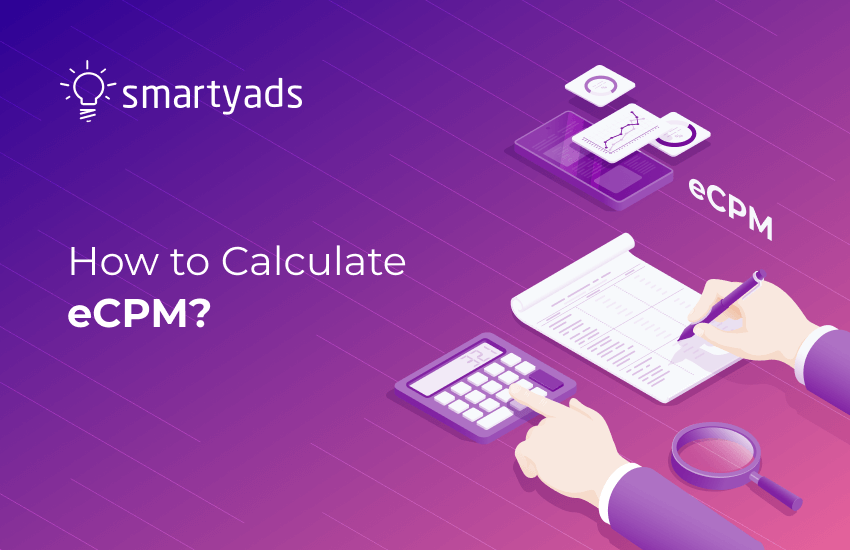Once you start working with web analytics in marketing, advertising or sales, you will certainly wonder what CPM is and what is the difference between CPM and eCPM. You won't miss it, since this is one of the popular tools for evaluating the cost of an advertising campaign. Not only on the Internet but also in print media, radio and television.
It's no secret that the cost-to-income ratio shows the effectiveness of an advertising campaign. That's why marketers analyze CPM values as well as other metrics to formulate the most profitable strategies to align long-term business and budget goals.
Without forecasting costs, businesses cannot launch an effective campaign. When calculating costs and revenues, marketers rely on one of the existing models for estimating the advertising budget.
In this article, we are going to provide an answer to the question “what is eCPM”, then we’ll explain how to calculate it. However, before we start with eCPM, let's take a closer look at CPM first.
What is CPM
CPM stands for Cost Per Millenium, that is, the cost per thousand impressions of a banner, ad, or any other commercial unit. Millenium (or abbreviated Mille) is a Latin word for 1 000. So, every time an advertiser has their ad shown 1 000 times, the cost for those ad views is the CPM.
This payment model came from the traditional media. Print media and television work for the mass popularization of advertisers' brands, so the cost is calculated for a thousand consumers, and not for a single viewer.
Features of the cost-per-mile model:
- Counts each ad view regardless of whether the user clicks on it or ignores it.
- Ad clicks are free, only impressions are counted.
- The advertising will be shown to your target audience which is a specific group of consumers who most likely want to buy your product or service.
- User activity on the publisher’s sites determines the period of time within which the ad gains 1 000 impressions. The more activity, the faster the ad gains impressions.
When to consider CPM?
There are no bad ad pricing models — there are badly planned campaigns. If a company chooses the wrong strategy, then it shouldn't be surprising that the implementation of the CPM model can lead to rather disappointing results. Still, there are several cases when businesses should consider CPM for their ad campaigns.
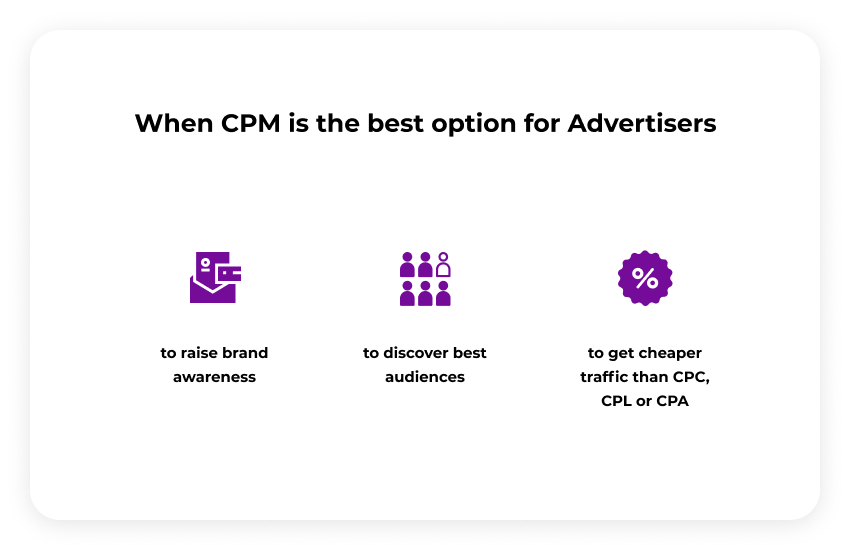
Cost-per-mile is best when you want to announce a launch of a new product or service, popularize your brand, or trademark. Payment for impressions is also suitable when informing customers about discounts, promotions, sales, and other loyalty programs. Typically, these ads require large budgets, because the effectiveness of a campaign is directly dependent on how often ads are shown. You can specify the cost per 1000 ad impressions, and, based on the offered price, ad platform will schedule them.
The CPM model is often used by startups to build brand awareness and strengthen their market position, as well as by popular brands to promote a new product or service. The effectiveness of ad views is defined by the number of clicks (CTR) on the ad.
If the click-through rate is too low, you’re probably not going to achieve a return on your advertising investment. This means you should check the ad settings as well as make sure that you offer something that your target audience would like to purchase.
How to calculate CPM?
The classic formula for calculating the cost of 1 000 impressions includes only two values. The first is the cost of placing an ad, the second is the total number of views of the ad.
Let’s say you're running a display advertising campaign. You get 10 000 impressions and it costs $10. What is your CPM? The CPM formula is quite simple:
CPM = (total ad spend/ total ad impressions) x 1000 impressions.
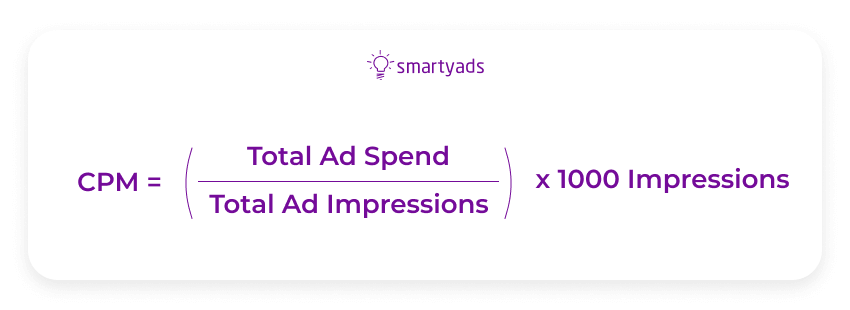
1 step: divide total ad spend by total impressions
2 step: multiply it by 1 000.
That's going to give you what your CPM is.
In this case, 10 divided by 10 000 is 0,001. 0,001 times 1 000 equals 1 dollar. So, that would be your total CPM for the ad campaign.
What is eCPM in advertising?
What does eCPM mean? Let’s take a closer look at eCPM definition: eCPM (effective Cost Per Mille or effective cost per thousand impressions) is a publisher's metric that characterizes the revenue of a publishing platform generated from a thousand ad impressions. The higher the eCPM, the higher the publisher's income from ad campaigns. In the next paragraph, we are going to clarify CPM vs. eCPM, and how not to avoid confusion between these two acronyms.
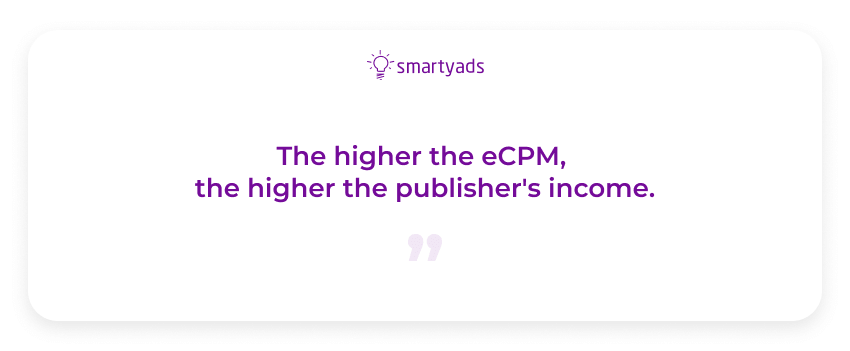
eCPM vs. CPM
So, what's the difference between CPM and eCPM? Now, when you know the eCPM meaning, you see that eCPM is similar to CPM. Still, CPM calculations take into account a fixed price one advertiser is willing to pay for a thousand impressions, while eCPM defines the ad revenue generated from multiple advertisers who bid on impressions with different CPMs. In addition, eCPM allows publishers to measure the average ad revenue per thousand impressions.
The other difference between CPM and eCPM is that CPM is an ad-buying model, while eCPM is a revenue metric that can be applied to any pricing method. It means that eCPMs can be calculated not just for CPM campaigns, but also for other pricing methods like CPC or CPA.
Is there a difference between eCPM and eRPM?
Nothing but semantics really. eCPM and eRPM (effective Revenue Per Mille) usually refer to the same concept. The only difference is the context they are used for. Traditionally, eCPM is an advertiser's metric as it defines the cost of the campaign, and ePRM is a publisher's metric as it defines the revenue from the advertiser's campaign.
Since this might seem confusing to talk about the same numbers in different languages, publishers try to use the term "eCPM" when they talk to advertisers.
How to calculate eCPM: eCPM Formula
eCPM calculation formula is quite simple:
eCPM = (total ad revenues/ total ad impressions) x 1000 impressions.
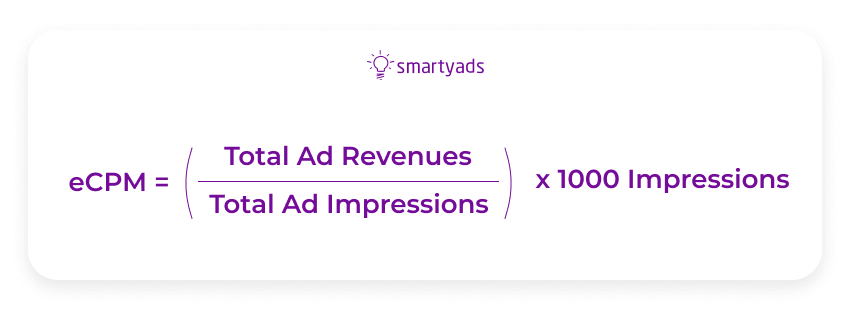
How to calculate an average eCPM for multiple ad campaigns?
Let's say, there were two ad campaigns with different CPMs. The first advertiser paid $10 for 2 000 impressions, and the second one paid $12 for 3 000 impressions. This means the publisher generated total revenue of $22 per 5 000 impressions.
The eCPM would be calculated as follows: ($22/ 5 000) x 1 000 = $4,4
How to calculate eCPM for other ad-buying models?
Let's imagine you want to calculate eCPM for a CPC (cost-per-click) campaign. The first step is to multiply the number of clicks by the cost-per-click rate. This will give you a total revenue. The second step is to divide the number of ad views by 1 000. This will give you the number of every 1 000 impressions.
For example, the ad campaign was shown 1 million times, where the ad server counted 2 000 clicks. The CPC rate for the campaign was $1. To calculate total revenue multiply 2 000 clicks by $1. This will give you $2 000. Now, let's calculate how many times the ad gained 1 000 impressions. For this, divide 1 million ad views by 1 000. This will give you 1 000.
So, let's calculate the eCPM: $2 000/ 1 000 = $2
How to increase your eCPM?
Don’t worry if your eCPM is too low. There are several ways to improve it.
Partner with Ad Mediation Agencies/SSPs
What is ad mediation? It is an SSP (Supply Side Platform) that allows app publishers to manage multiple ad networks, helping simplify the entire monetization process.
By working with an ad mediation platform, there is no need to manually calculate and compare the eCPM of multiple ad networks. With the help of an SSP, you make your inventory available to multiple bidders and the highest bid wins which helps increase the overall revenue, thus boosting your eCPM.
Try Smartyads SSP that offers opportunities for web publishers to maximize advertising revenues directly. SmartyAds SSP provides complete control over ad inventory and full transparency at all levels. The SSP works with different demand sources such as DSPs, Ad Networks, Ad Exchanges, etc. which guarantees that your inventories will be open to more bidders, thus improving your eCPM.
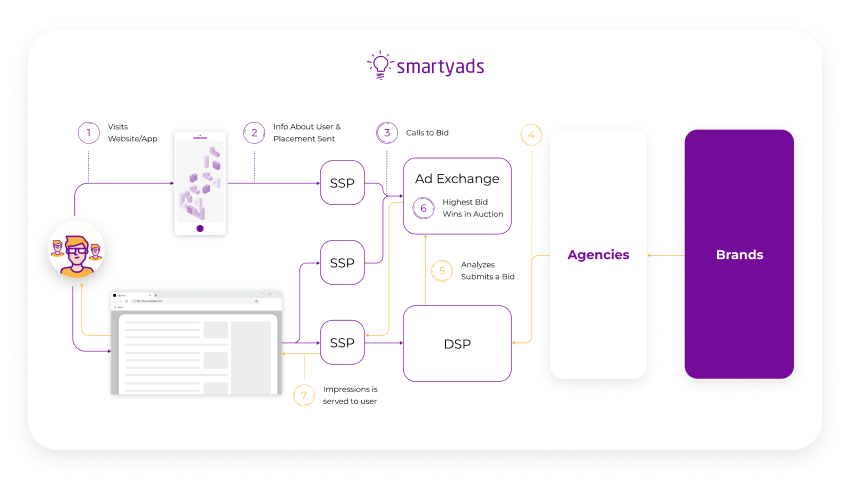
Try Different Ad Formats
Nowadays, there are a bunch of digital ad formats that companies use to promote their businesses: banners, offer walls, interstitials, videos, etc. Our advice is to regularly check which of them work for you and which don't. If you've noticed that a specific ad unit consistently has a low eCPM, remove it from your ad supply.
However, some formats have historically performed better. For example, try rewarded video ad format. With rewarded video, you give users virtual currency or items in exchange for viewing ads.
Changing the Ad Placement
Play around with different ad placements and see where it works best. Also, try to experiment with the number of ads. The goal is to display ads in the place and moment when the users are the most active. However, it shouldn't hurt user experience and site usability.
Keep up with the Industry eCPM
Keep yourself updated with industry standards. Remember, ad formats evolve - those formats that are in high demand today might not be that performing tomorrow, and vice versa. That's why you should regularly check the average eCPM of different ad formats.
Make Your Site Mobile-Friendly
Did you know that the majority of internet traffic comes from mobile? Try to optimize your website for mobile. For that, you can start with implementing AMP which is a good option to make your website work faster as well as to adapt your ads for mobile screens.
Generate Search Engine Traffic
With good SEO practices, you get organic search users who came to your website to fulfill an informational need. Moreover, by publishing high-quality content you motivate the users to spend more time on your website which allows increasing the eCPM.
Increase your ad viewability rate
Viewability rate is the percentage of ads that your users actually see. Only those ads count as viewable that are at least 50% on screen for one second or longer. For example, your website has eight ad impressions, but only four of them are viewable. This means your viewability rate is 50%. By improving the viewability rate, your website becomes more appealing for advertisers.
Summing Up
eCPM is an ultimate metric for publishers to evaluate and optimize their monetization. eCPM delivers one of the most effective methods to measure the revenue performance and the campaign costs for better forecasting. By calculating eCPM, you can also analyze the effectiveness of placing advertisements as well as compare the performance of various advertising formats.
